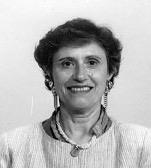Education and early career
Although born in Tunisia, she graduated in 1947 from high-school in Algiers, at that time part of France. Following this she attended preparatory scientific university level classes at Lycée Bugeaud, later called Lycée Émir-Abdelkader [ fr ], from 1947 to 1949. [10] [11] Placed first in a national entrance competition, she entered the École normale supérieure de Sèvres in Paris. [12] In 1953 she is placed first, in the French national competition for physical sciences (Les agrégés de l'enseignement secondaire). [13]
From 1953 to 1959 she was research associate (attachée de recherche) of the French National Centre for Scientific Research (CNRS) at the Saclay center of the Commissariat à l'Énergie Atomique, working mainly on slow neutron scattering and magnetism. She also prepared her PhD thesis in experimental physics, which she defended at Sorbonne University in 1958. [14] As stated by J. Friedel "The agreement (of the van Hove model [15] [16] ) with Ericson's measurementswas good enough for them (the later Nobelprize winner de Gennes and Ericson) both to present their theses in quick succession". [17] Ericson's pioneering results demonstrate the power of slow neutron scattering for investigating condensed matter.
In spite of these achievements, her temporary position with CNRS was not renewed in 1959. For health reasons she abandoned experiments in favor of theoretical research, first in plasma physics. She received a Fulbright scholarship and spent one year at MIT as a postdoctoral researcher in the plasma physics group of Sanborn C. Brown. During this period she found the explanation of an unexpectedly observed plasma constriction. [18]
Career and later research
After her return to France, she obtained a position as a lecturer at the University of Lyon. In 1967 she is promoted to professor in the same place, a position she kept until her formal retirement in 1995. [3] [19] She continues her research, and publishes actively, to this day (2022), [20] as professor emeritus. Concurrently, her research is pursued at CERN as part-time unpaid visiting scientific associate—a status she has held since 1963. [21] [22]
Back in Europe, she abandoned a career in experimental physics turning to theoretical physics in the just emerging sub-field in the intersection of nuclear and particle physics, in particular concerning the role of the pion in a nuclear context. [23] This was a fortunate decision since it turned out later that her new field of pion-nuclear physics has various useful analogies to her previous field in condensed matter. A major example is the Ericson-Ericson Lorentz-Lorenz effect for low energy pions, which she examined in detail with Torleif Ericson in a basic paper in 1966, an article that over time has been widely cited. [4] [24] Following the developments of pion low energy theorems, and PCAC in elementary particle physics, she applied in 1969 these techniques to the pion-nucleus threshold interactions, where the finite size of the nucleus presented a conceptual hurdle. [25] [26] [27] This made her study this phenomenon in a wider perspective. She found that the low energy pion-nuclear equations have a nearly exact counterpart in Maxwell equations for a polarized medium. [28] This leads in particular to an understanding of how a basic property of the free neutron beta decay is modified in the nuclear environment by a pion effect, [29] [30] [31] [32] [33] and the explanation of the characteristic quenching effects observed in the low-energy Gamow–Teller transitions. [31]
Ericson drew, in the early eighties, attention to the role of pionic physics as one of the origins of the EMC effect. [6]
More recently her research concerns neutrino-nuclear interactions at higher energy, the understanding of which is essential for particle physics research. She has given the explanation of the so-called 'axial anomaly'. [34]
Ericson's active career spans over seven decades. [8]
This page is based on this
Wikipedia article Text is available under the
CC BY-SA 4.0 license; additional terms may apply.
Images, videos and audio are available under their respective licenses.
